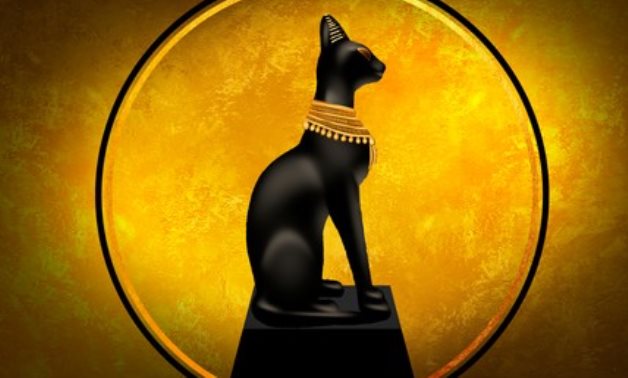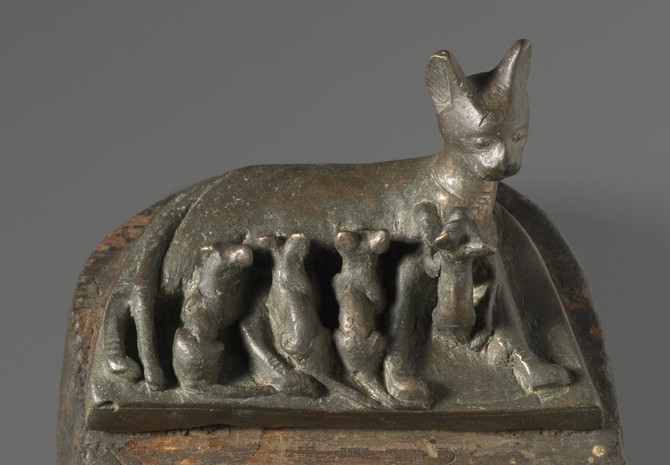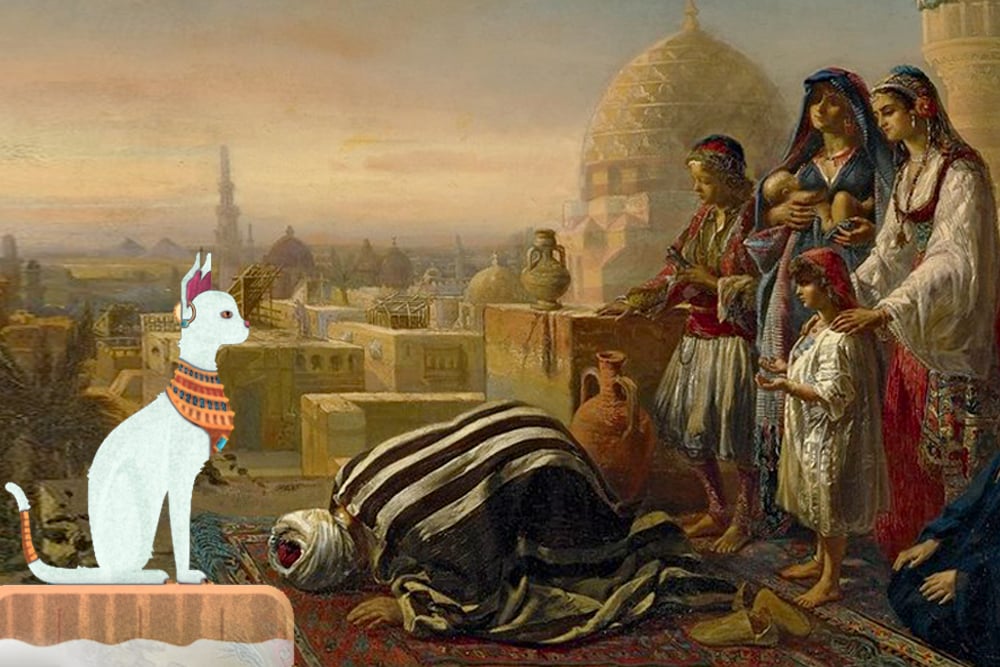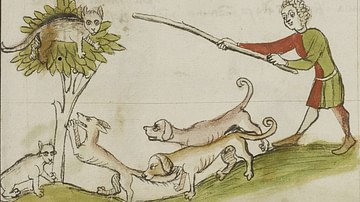Egyptians believed cats were magical creatures

Felines and people have partaken in one another's lives for millennia and, despite the fact that they have not generally been viewed as exceptionally as in the present, have assumed a significant part in various societies. Continuously cryptic, the feline has in some cases been questioned by different developments however consistently figured out how to demonstrate their value.

Despite the fact that it has been regularly acknowledged that felines were first trained in Egypt 4000 years prior, their set of experiences among people returns a lot further. Wild felines are presently known to have lived among individuals of Mesopotamia more than 100,000 years prior and to have been trained there roughly 12,000 BCE at about similar time as canines, sheep, and goats. Archeological unearthings in the beyond ten years have given proof that the Near Eastern Wildcat is the nearest relative of the cutting edge homegrown feline and was reared by Mesopotamian ranchers, most presumably as a method for controlling vermin, like mice, which were drawn in by grain supplies.
The essayist David Derbyshire refers to a 2007 CE research project in which, "the review utilized DNA tests from 979 wild and homegrown felines to sort out the catlike genealogical record. They searched for markers in mitochondrial DNA - a sort of hereditary material passed down from moms to little cats which can uncover when wild and homegrown feline ancestries were most firmly related." This task was going by Dr. Andrew Kitchener, a Zoologist at the National Museums of Scotland, who expresses, "This shows that the beginning of homegrown felines was not Ancient Egypt - which is the common view - yet Mesopotamia and that it happened a whole lot sooner than was suspected. The last normal precursor of wildcats and tamed felines lived over 100,000 years prior" (Derbyshire).
Dr. Kitchener's discoveries based upon the proof of feline's training given by the revelation in 1983 CE of a feline skeleton in a grave dating to 9,500 BCE on the island of Cyprus. This find, made by the excavator Alain le Brun, was significant in light of the fact that Cyprus had no native feline populace and it is impossible that pioneers would have brought a wild feline, by boat, to the island.
Cat in Ancient Egypt

The feline's relationship with antiquated Egypt, in any case, is reasonable in that Egyptian culture was renowned for its dedication to the feline. The fare of felines from Egypt was excessively stringently disallowed to the point that a part of the public authority was shaped exclusively to manage this issue. Government specialists were dispatched to different grounds to discover and return felines which had been carried out. It is unmistakably settled that, by 450 BCE, the punishment in Egypt for killing a feline was demise (however this law is thought to have been noticed a whole lot sooner). The goddess Bastet, generally portrayed as a feline or as a lady with a feline's head, was among the most famous divinities of the Egyptian pantheon. She was the attendant of hearth and home, defender of ladies' mysteries, gatekeeper against abhorrent spirits and illness, and the goddess of felines.

Her custom community was the city of Bubastis ("House of Bastet") wherein, as per Herodotus (484-425 BCE), a colossal sanctuary complex was underlying her honor in the focal point of the city. Herodotus likewise relates that the Egyptians really focused such a huge amount on their felines that they set their security above human existence and property. At the point when a house burst into flames, the Egyptians would concern themselves more with protecting the felines than with whatever else, frequently running once again into the consuming structure or shaping an edge around the blazes to maintain felines at a protected separation.
At the point when a feline passed on, Herodotus states, "Every one of the occupants of a house shave their eyebrows [as an indication of profound mourning]. Felines which have kicked the bucket are taken to Bubastis where they are treated and covered in sacrosanct repositories" (Nardo 117). The time of grieving was viewed as finished when individuals' eyebrows had become back. Preserved felines have been found at Bubastis and somewhere else all through Egypt, in some cases covered with, or close to, their proprietors as confirmed by recognizing seals on the mummies.

The best illustration of Egyptian commitment to the feline, in any case, comes from the Battle of Pelusium (525 BCE) in which Cambyses II of Persia crushed the powers of the Egyptian Pharaoh Psametik III to overcome Egypt. Knowing about the Egyptian's adoration for felines, Cambyses had his men gather together different creatures, felines mostly among them, and drive the creatures before the attacking powers toward the sustained city of Pelusium on the Nile.
The Persian fighters painted pictures of felines on their safeguards, and may have held felines in their arms, as they walked behind the mass of creatures. The Egyptians, hesitant to safeguard themselves inspired by a paranoid fear of hurting the felines (and maybe causing capital punishment should they kill one), and crippled at seeing the picture of Bastet on the adversary's safeguards, given up the city and let Egypt tumble to the Persians. The history specialist Polyaenus (second century CE) composes that, after the acquiescence, Cambyses rode in win through the city and heaved felines into the essences of the crushed Egyptians in disdain.

The Egyptians are additionally liable for the very name 'feline' in that it gets from the North African word for the creature, "quattah", and, as the feline was so firmly connected with Egypt, pretty much every other European country utilizes minor departure from this word: French, talk; Swedish, katt; German, katze; Italian, gatto; Spanish, gato, etc (Morris, 175). The everyday word for a feline - 'puss' or 'pussy' - is likewise connected with Egypt in that it gets from the word Pasht, one more name for Bastet.
Cats In India
Felines are referenced in the two incredible abstract legends of old India, The Mahabharata and The Ramayana (both c. fifth/fourth century BCE). In Mahabharata a popular entry concerns the feline Lomasa and the mouse Palita, who help each other break from death and talk about finally the idea of connections, especially those where one of the gatherings is more grounded or more impressive than the other. In the Ramayana, the god Indra camouflages himself as a feline in the wake of luring the wonderful house keeper Ahalya as a way to escape from her better half. Similar to the case wherever else, felines in India were observed to be especially valuable in controlling the populaces of less alluring animals like mice, rodents, and winds as were respected in the homes, ranches, and castles all through the land.
That the feline was viewed as something other than a technique for bother control is validated by the adoration concurred to cats in the writing of India. The renowned story of Puss in Boots (most popular through the French rendition by Charles Perrault, 1628-1703 CE) is taken from a lot more established Indian classic story in the Panchatantra from the fifth century BCE (however the personality of the feline's lord has a totally different character in the more seasoned story than the one in Perrault's story). The regard in which felines were held is additionally clear in the Indian feline goddess, Sastht, who served a lot of a similar job as Bastet and was as extraordinarily worshipped.
The Persian Cat

A Persian story asserts the feline was made mysteriously. The incomparable Persian legend Rustum, out on crusade, one night saved a performer from a band of criminals. Rustum offered the more established man the friendliness of his tent and, as they sat outside under the stars, partaking in the glow of a fire, the entertainer asked Rustum what he wanted as a gift in reimbursement for saving the man's life. Rustum revealed to him that there was nothing he wanted since all that he could need, he previously had before him in the glow and solace of the fire, the aroma of the smoke and the excellence of the stars overhead. The performer then, at that point, took a modest bunch of smoke, added fire, and cut down two of the most brilliant stars, manipulating them together in his grasp and blowing on them. At the point when he opened his hands toward Rustum, the hero saw a little, smoke-dim cat with eyes splendid as the stars and a minuscule tongue which dashed like the tip of fire. Along these lines, the principal Persian feline came to be made as a badge of appreciation to Rustum.
The prophet Muhammed was additionally exceptionally enamored with felines. As indicated by legend, the 'M' plan on the temple of the dark-striped feline was made when the prophet favored his #1 feline by setting his hand on its head. This feline, Meuzza, additionally includes in one more popular story in which Muhammed, called to petition, discovered the feline sleeping on his arm. Maybe than upset the feline, Muhammed cut the sleeve from his robe and left Meuzza to rest. The situation with the feline, in this way, was additionally upgraded by its relationship with a figure of godliness.
Cats in China and Japan

This was likewise obvious in China where the goddess Li Shou was portrayed in feline structure and petitions and forfeits made to her for bug control and ripeness. She as well, was an extremely famous goddess who was thought to exemplify the significance of felines in the beginning of creation. An antiquated Chinese fantasy relates that, in the start of the world, the divine beings designated felines to manage the running of their new creation and, with the goal for correspondence all things considered, allowed felines the force of discourse. Felines, in any case, were more keen on dozing underneath the cherry trees and playing with the falling blooms than with the ordinary assignment of focusing on the activity of the world.
Multiple times the divine beings came to keep an eye on how well the felines were tackling their work and every one of the multiple times were disillusioned to track down their catlike supervisors sleeping or at play. On the god's third visit, the felines clarified they had no interest in running the world and named people for the position. The force of discourse was then taken from the felines and given to people at the same time, as people appeared to be unequipped for understanding the expressions of the divine beings, felines remained depended with the significant errand of keeping time thus keeping control. It was believed that one could tell the hour of day by investigating a feline's eyes and this conviction is as yet kept up with in China.
In Japan, the popular picture of the 'Coaxing Cat' (the maneki neko figure of the feline with one raised paw) addresses the goddess of kindness. The legend goes that a feline, sitting outside of the sanctuary of Gotoku-ji, brought her paw up in affirmation of the head who was cruising by. Drawn in by the feline's motion, the ruler entered the sanctuary and, minutes after the fact, lightning struck the very spot where he had been standing. The feline, consequently, saved his life and was concurred significant privileges.
The Beckoning Cat picture is thought to bring best of luck when given as a gift and stays an exceptionally well known present in Japan. The feline was consistently viewed as a gatekeeper of the home and was believed to be the extraordinary defender of important books. Felines were frequently housed in private pagodas in Japan and were thought about so important that, by the tenth century CE, just the honorability could stand to possess one.
Cats in Greece and Rome

In spite of the fact that felines were kept by individuals in Greece and Rome, the appreciation for the creature as a tracker was not as incredible in those societies attributable to the Greek and Roman act of keeping trained weasels for bug control. The Romans viewed the feline as an image of autonomy and not as an animal of utility. Felines were kept as pets by the two Greeks and Romans and were respected profoundly.
A first century CE inscription of a young lady holding a feline is among the soonest bits of proof of felines in Rome and, in Greece, the dramatist Aristophanes (c. 446-386 BCE) much of the time highlighted felines in his works for comic impact (instituting the adage, "The feline did it" in relegating fault). Among old developments, nonetheless, the feline was presumably least famous among the Greeks attributable to its relationship in specific legends with the goddess of death, dimness and witches, Hecate, who is all the more normally connected with the canine (similar to her Roman conterpart, Trivia). A lot later advancement in Greek appreciation for the feline is proven in the legend that the feline shielded the child Jesus from rodents and winds as is agreed awesome of spots in a Greek home yet, initially, they don't appear to have been respected exceptionally.
Felines are thought to have been brought to Europe by Phoenician brokers who pirated them out of Egypt. As the Phoenicians are recognized to have broadly exchanged with each known human advancement of the time, felines might have been spread around the district on a genuinely standard premise. It is all around archived that felines were kept on boats to control vermin during the hour of the fifteenth century CE Age of Discovery and, in all probability, they filled similar need for the Phoenicians. On the off chance that the Phoenicians carried the feline to Europe, as appears to be probable, they might have additionally presented the Greek relationship of the feline with Hecate. As verified above, Hecate was related with canines routinely yet one story specifically, which was very well known, joins the dull goddess with the feline.
The Greek legend which recommends this connection is the notable story of Heracles (the Roman Hercules) and concerns Galinthius, a house keeper worker to Heracles' mom, the Princess Alcmene. The god Zeus enticed Alcmene and she became pregnant with Heracles. Zeus' significant other, Hera, was obstructed in her endeavor to kill Alcmene and Heracles through the intelligence of Galinthius. Angered, Hera changed Galinthius into a feline and sent her to the hidden world to ever after serve Hecate. This story was advocated by the Latin essayist Antoninus Leberalis (second century CE) in his Metamorphosis, a retelling of more established stories, which was adequately famous to be duplicated and conveyed up through the ninth century CE and to partake in a wide readership through basically the sixteenth century CE. This fantasy, then, at that point, related felines with dimness, change, the hidden world, and black magic and, on schedule, these affiliations would demonstrate extremely appalling for the feline.
Cat as Demonic Figures

In spite of the fact that felines appear to have partaken in their antiquated elevated status in European nations from the outset (in Norse folklore, for instance, the incredible goddess Freya is portrayed in a chariot drawn by felines and in both Ireland and Scotland felines are portrayed as mysterious from an inspirational outlook) the Christian Church, following their ordinary course of defaming significant agnostic images, drew on the prior interface between the feline and black magic to relate felines with malicious as exemplified in the Devil. The middle age essayist Walter Map (c. 1140-1210 CE) connected the feline with satanic powers in his work (despite the fact that it is conceivable Map was being stirical) and there are records of felines being ceremonially killed in Cambridge England in the mid thirteenth century CE.
The standing of the feline took a more genuine descending turn, notwithstanding, after Pope Gregory IX (1227-1241 CE) gave his ecclesiastical bull known as Vox in Rama in 1233 CE reviling felines as malevolent and allied with Satan, felines - and particularly dark felines - were slandered to where they were consistently killed all over Europe. It ought not be expected that the everyday citizens would have perused Vox in Rama and reacted to it, nor even that the bull was boundless (it was given distinctly to Henry III, Count of Sayn, in Germany) however the assessment of the congregation toward felines would positively have sifted down from the most significant levels to the laypeople of the assemblies.
It has for some time been contended that the demise of so many felines permitted the mice and rodent populaces to flourish and that the bugs these vermin conveyed achieved the Bubonic Plague of 1348 CE. While this hypothesis has been questioned, there appears to be no question that a lessening in the feline populace would bring about an increment in the quantity of mice and rodents and it is set up that there was such a reduction in the quantity of felines preceding 1348 CE. Despite the fact that new investigations have presumed that the plague was spread through human communication (not through cooperation with rodents) it was as yet the parasites from rodents and mice which conveyed the plague. Individuals of the time, notwithstanding, had no clue about where the plague came from (the bacterium Yersinia pestis,which causes plague, was not segregated until 1894 CE) and saw no relationship between's the quantity of rodents, felines, and the illness; thusly felines kept on being suspect of all way of malevolence and hazardous traits.
Desmond Morris states, "In light of the fact that the feline was viewed as malicious, a wide range of startling forces were ascribed to it by the journalists of the day. Its teeth were supposed to be venomous, its tissue toxic, its hair deadly (causing suffocation if a couple were unintentionally gulped), and its breath irresistible, obliterating human lungs and causing utilization" and further states, "As late as 1658 Edward Topsel, in his genuine work on normal history, [wrote] 'the familiars of Witches do most commonly show up looking like Cats, which is a contention that this monster is hazardous to soul and body" (158). The occupants of the European countries, accepting the feline to be underhanded, disregarded the creature as well as any individual who appeared to be excessively partial to the feline. Older ladies who really focused on felines were particularly powerless to discipline for black magic just on the grounds of being so denounced.
The Victorian Age and Cat Vindication

Felines endure these furious notions better than a significant number of their human partners and during the Enlightenment of the eighteenth century were raised to the situation with spoiled pets. This was because of the soul of the age and the new worldview of reason beating odd notion. The force of the congregation in directing prominent sentiment had been broken by the Protestant Reformation (1517-1648 CE) and in the Age of Enlightenment individuals could decide to accept what they needed to in regards to felines or some other subject.
During the Victorian Age (1837-1901 CE) felines were again raised to the past elevated status they had appreciated in antiquated Egypt. Sovereign Victoria of Great Britain, who had consistently kept canines as pets, became keen on felines through the numerous accounts of archeological finds in Egypt being distributed routinely in England. A considerable lot of these accounts included portrayals of the Egyptian worship for felines, pictures of sculptures of Bastet, and the catlike relationship with the divine beings and government. The sovereign's advantage in the feline drove her to embrace two Blue Persians whom she treated as individuals from her court. This story was conveyed by the papers of the day and, as Queen Victoria was an extremely well known ruler, an ever increasing number of individuals became keen on having felines of their own.
This pattern spread to the United States and was energized by the most well known magazine in America around then, Godey's Lady's Book. Distributed by Louis A. Godey of Philadelphia from 1830 - 1878, this month to month periodical included stories, articles, sonnets, and etchings and is maybe most popular for assisting with regulating the act of the family Christmas tree in America (in spite of the fact that it likewise upheld for ladies' privileges, schooling, the festival of Thansgiving, and was among quick to distribute Edgar Allen Poe's work).
In 1836 CE, the splendid supervisor and essayist Sarah Josepha Hale joined Godey's and significantly improved its standing and flow. In a 1860 article, Hale composed that felines were not exclusively for more seasoned ladies or rulers and that anybody should feel great in embracing the "affection and prudence" of the feline. Feline notoriety in the United States became apparently after the Godey article. Felines originally came to North America, it is thought, in 1749 CE, from England, to assist with controlling the mice and rodent populace yet they appear to have been generally viewed as utilitarian until the Victorian Age when they became esteemed pets and, in the United States, this was to a great extent because of the impact of Godey's Lady's Book and Sarah Hale's commitments to it.
Fame of Cats
Numerous essayists of the age possessed and appreciated felines. Charles Dickens was so committed to his felines that he permitted them into his review and routinely permitted his top choice (known as The Master's Cat) to snuff out the flame on Dickens' composing work area in any event, when the creator was busy working. Clearly, the feline would become worn out on Dickens' consideration being coordinated toward the page rather than to cat friendship and petting (Morris, 167). Imprint Twain, William Wordsworth, John Keats, and Thomas Hardy were all incredible admirers of the feline and Lewis Carroll, obviously, made one of the most suffering pictures of the cat through the Cheshire Cat in his Alice's Adventures in Wonderland.
The primary significant Cat Show was held at the Crystal Palace in London in 1871CE and enthusiasm for the feline was raised to such a level that, interestingly, felines were given "explicit norms and classes" which are as yet used to order cats in the current day (Morris, 148). Feline shows turned out to be progressively well known after this occasion and interest in rearing and showing felines spread all through Europe and North America. The principal feline show in America (in 1895 CE) .
Cats in ancient Egypt
Magical creatures in Egypt
Ancient Egyptian beliefs
Cats as sacred animals
Egyptian cat worship
Egyptian religious practices
The importance of cats in ancient Egyptian society
The mythology of felines in Egypt
Ancient Egyptian gods associated with cats


Comments
Post a Comment